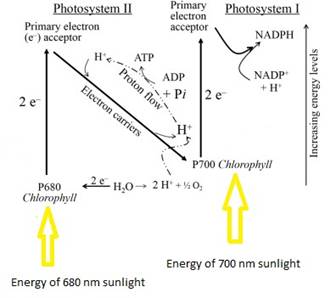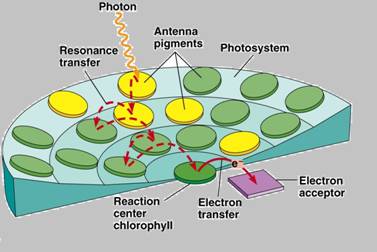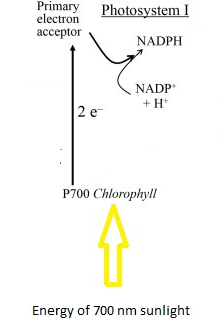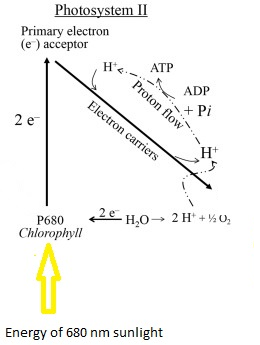
Concept explainers
(a)
Interpretation:
The most suitable matching pair should be selected.
Concept introduction:
Photosynthesis is the process by whichenergy of the sunlight is stored as chemical energy. The process takes place in the chloroplast of the plant cells in two main stages - light reaction and dark reaction.
Answer to Problem 8P
a) Light reactions − generates ATP, NADPH and O2
Explanation of Solution
Photosynthesis consists of two main stages - light reaction and dark reaction.
In light reaction, two photo systems (PS I and PS II) participate.
PSII absorb680 nmwavelengthof sunlight. After absorbing energy from the sunlight, chlorophyll a molecule in PSII release excited high energy electrons. The electron defect occurred in PSII is fulfilled by hydrolysis of water which produce O2as by product. Consider this as reaction 1.
Theelectronsfrom reaction I are used to fulfill the electron defect inphotosystem. The high energy electrons go through the series of electron acceptorsto assimilate this energy. ADP takes up the energy of these electrons to form ATP. This is known as photophosphorylation.
Similar reaction occurs in PS I. PSI absorb 700 nm wavelength of sunlight, followed by high energy electrons release. Like PSII, the high energy electron goes through a series of electron acceptors. At the end of this series NADP+accepts the electron to form NADPH. Consider this as reaction 2.

Figure 1: A diagrammatic representation of light reaction
(b)
Interpretation:
The most suitable matching pair should be selected.
Concept introduction:
Photosynthesis is the process by which energy of the sunlight is stored as chemical energy. The process takes place in the chloroplast of the plant cells in two main stages - light reaction and dark reaction.
Answer to Problem 8P
b) Chloroplasts − cellular location of photosynthesis
Explanation of Solution
Chloroplast is the organelle in a plant cell which is responsible for conducting photosynthesis. Chloroplast consists of a double membrane structure known as thylakoid. Thylakoids are the primary site for light reaction which assimilate the light energy to produce the energy moieties, ATP and NADPH. These energy molecules are used in the dark reaction to produce six carbon sugar molecule and oxygen as byproduct. The dark reaction takes place in the stroma of chloroplast.
(c)
Interpretation:
The most suitable matching pair should be selected.
Concept introduction:
Photosynthesis is the process by which energy of the sunlight is stored as chemical energy. The process takes place in the chloroplast of the plant cells in two main stages - light reaction and dark reaction.
Answer to Problem 8P
c) Reaction Center − site of photoinduced charge separation.
Explanation of Solution
In light reaction, two photosystems called PS I and PS II participate.
In these photosystems, the reaction center is a special chlorophyll a molecule, chlorophyll a. The process happening in these two systems is quite similar.
PSII absorbs light energy of 680 nm wavelength of light while PS I absorb energy of 700 nm wavelength of light, followed by releasing high energy electrons.
When the chlorophyll a molecule releases its electrons, the chlorophyll molecule gets positively charged. It generates the charge separation at the chlorophyll molecules. This charge separation is due to the absorbed light energy. So, it is known as photo induced charge separation.
A photosynthetic reaction center is a complex structural view. It is composed of several proteins, pigments and other co-factors. It is a collection of CF1− CF0 complex. This is responsible for executing the primary energy conversion reactions related to photosynthesis. Molecular excitations occur at the reaction center give rise to electron transfer reactions along the path of a series of protein-bound co-factors like chlorophylls.
(d)
Interpretation:
The most suitable matching pair should be selected.
Concept introduction:
Photosynthesis is the process by which energy of the sunlight is stored as chemical energy. The process takes place in the chloroplast of the plant cells in two main stages - light reaction and dark reaction.
Answer to Problem 8P
d) Light-harvesting complex- Primary photosynthetic pigment
Explanation of Solution
Photosynthesis is the process by which energy of the sunlight is stored as chemical energy. The process takes place in the chloroplast of the plant cells in two main stages - light reaction and dark reaction. In the light reaction, the sunlight is assimilated, and the energy is stored in the
The photosynthetic pigments such as chlorophyll a and b, xanthophyll and carotenoids form the two photosystems (Photosystem I and II) which absorbs different wavelength of light. Chlorophyll a form the reaction center of the photosystems.
(e)
Interpretation:
The most suitable, matching pair of answers should be selected.
Concept introduction:
A light-harvesting complex is a collection of subunit proteins. These subunit proteins are again a part of largersupercomplex of a photosystem.
Answer to Problem 8P
e) Light − harvesting complex − uses resonance energy transfer to reach the reaction center
Explanation of Solution
A light-harvestingcomplex (also known as photosystem)is a collection of proteins.The light harvest system is used by plants and photosynthetic bacteria to collect energy from sun light. During photosynthesis, the reaction centers absorbs light energy of 680nm and 700 nm sun light. This reaction center is a special chlorophyll a molecule. Light harvesting complex assist on this energy absorbance.
Light-harvesting complexes show a huge variation among the different photosynthetic organisms. The complexes consist of proteins and photosynthetic pigments like chlorophylls and surround by the photosynthetic reaction center. This special structural adaptation is to focus energy, absorbed from the photons toward the reaction center as resonance transfer.

Figure 3: close view of a light harvesting complex
(f)
Interpretation:
The most suitable matching pair of answers should be selected.
Concept introduction:
Photosynthesis is the process by which energy of the sunlight is stored as chemical energy. The process takes place in the chloroplast of the plant cells in two main stages - light reaction and dark reaction.
For the light reaction two photosystems called PS I and PS II participate.
Answer to Problem 8P
f) Photosystem I − powers the formation of NADPH
Explanation of Solution
Photosystem is a collection of pigment moleculesand is known as light harvest complex. In photosystem I, PS I absorb energy from 700 nm photons of sunlight, followed by releasing high energy electrons. The electron goes through a series of electron acceptors. At the end of this series NADP reacts with electron to form NADPH.

Figure 4: Figure 5: Diagrammatic representation of reactions happen in photosystem one
(g)
Interpretation:
The most suitable, matching pair of answers should be selected.
Concept introduction:
Photosynthesis is the process by which energy of the sunlight is stored as chemical energy. The process takes place in the chloroplast of the plant cells in two main stages - light reaction and dark reaction.
For the light reaction two photosystems called PS I and PS II participate.
Answer to Problem 8P
g) Photosystem II − Transfer electron from H2O to P680.
Explanation of Solution
For the light reaction two photosystems called PS I and PS II participate. PSII absorbs light energy of 680 nm wavelength of sun light After absorbing energy the chlorophyll a molecule in PSII releases excited, high energy electrons. To fulfill the electron defect occurred at PSII water hydrolysistakes place at PSII.
These released electrons are used to overcome the electron defect in photosystemII.

Figure : Diagrammatic representation of reactions happen in photosystem one
(h)
Interpretation:
The most suitable, matching pair of answers should be selected.
Concept introduction:
The chloroplast cytochrome bf complex is a collection of multiple numbers of subunit proteins.
Answer to Problem 8P
h) Cytochrome bf complex − pumps protons
Explanation of Solution
The chloroplast cytochrome bf complex is a collection of multiple numbers of subunit proteins. These subunit proteinsconsist of four polypeptides. These four types are
- Cytochrome f
- Heme containing cytochrome b 6
- Rieske iron-sulfur protein
- 17 kD polypeptide
Most mechanisms suggest that the transfer of a single reducing equivalent which is an electron results in the translocation of two protons across the membrane. So, this complex mainly workes as a proton pump.
(i)
Interpretation:
The most suitable, matching pair of answers should be selected.
Concept introduction:
Photosynthesis is the process by storing energy of sunlight as chemical energy in glucose. Process happens in the chloroplast of a plant cell. Photosynthesis happens via two main stages as light reaction and dark reaction.
Answer to Problem 8P
i) Water -oxidizing complex- site of oxygen generation.
Explanation of Solution
For the light reaction, two photosystems called PS I and PS II participate. PSII absorbs light energy of 680 nm wavelength of sun light After absorbing energy the chlorophyll a molecule in PSII releases excited, high energy electrons. To fulfill the electron defect occurred at PSII water hydrolysis takes place at PSII.
The hydrolysis of water is taken care of by water oxidizing complex. Thereleased electrons are used to overcome the electron defect in photosystem II.
(j)
Interpretation:
The most suitable matching pair should be selected.
Concept introduction:
A photosynthetic reaction center is a complex structural. It is composed of several proteins, pigments and other co-factors. It is a collection of CF1− CF0complex.
Answer to Problem 8P
j) ATP synthase − CF1- CF0 complex
Explanation of Solution
A photosynthetic reaction center is a complex structural. It is composed of several proteins, pigments and other co-factors.It is a collection of CF1− CF0 complex. This is responsible for executing the primary energy conversion. The energy is stored in the form of ATP via this complex.
Want to see more full solutions like this?
Chapter 19 Solutions
Biochemistry
- Sodium fluoroacetate (FCH 2CO2Na) is a very toxic molecule that is used as rodentpoison. It is converted enzymatically to fluoroacetyl-CoA and is utilized by citratesynthase to generate (2R,3S)-fluorocitrate. The release of this product is a potentinhibitor of the next enzyme in the TCA cycle. Show the mechanism for theproduction of fluorocitrate and explain how this molecule acts as a competitiveinhibitor. Predict the effect on the concentrations of TCA intermediates.arrow_forwardIndicate for the reactions below which type of enzyme and cofactor(s) (if any) wouldbe required to catalyze each reaction shown. 1) Fru-6-P + Ery-4-P <--> GAP + Sed-7-P2) Fru-6-P + Pi <--> Fru-1,6-BP + H2O3) GTP + ADP <--> GDP + ATP4) Sed-7-P + GAP <--> Rib-5-P + Xyl-5-P5) Oxaloacetate + GTP ---> PEP + GDP + CO 26) DHAP + Ery-4-P <--> Sed-1,7-BP + H 2O7) Pyruvate + ATP + HCO3- ---> Oxaloacetate + ADP + Piarrow_forwardTPP is also utilized in transketolase reactions in the PPP. Give a mechanism for theTPP-dependent reaction between Xylulose-5-phosphate and Ribose-5-Phosphate toyield Glyceraldehyde-3-phosphate and Sedoheptulose-7-Phosphate.arrow_forward
- What is the difference between a ‘synthetase’ and a ‘synthase’?arrow_forwardIn three separate experiments, pyruvate labeled with 13C at C-1, C-2, or C-3 is introduced to cells undergoing active metabolism. Trace the fate of each carbon through the TCA cycle and show when each of these carbons produces 13CO2.a. Glucose is similarly labeled at C-2 with 13C. During which reaction will this labeled carbon be released as 13CO2?arrow_forwardDraw the Krebs Cycle and show the entry points for the amino acids Alanine,Glutamic Acid, Asparagine, and Valine into the Krebs Cycle. How many rounds of Krebs will be required to waste all Carbons of Glutamic Acidas CO2?arrow_forward
- Suppose the data below are obtained for an enzyme catalyzed reaction with and without the inhibitor I. (s)( mM) 0.2 0.4 0.8 1.0 2.0 4.0 V without i (mM/min) 5.0 7.5 10.0 10.7 12.5 13.6 V with I (mM/min) 3.0 5.0 7.5 8.3 10.7 12.5 Make a Lineweaver Burke plot for this data using graph paper or a spreadsheet Calculate KM and Vmax without inhibitor. What type of inhibition is observed? show graph and work 2. Give the Lineweaver Burk equation and define all the parameters. 3. When substrate concentration is much greater than Km, the rate of catalysis is almost equal to a. kcat b. none of these c. all of these d. Kd e. Vmaxarrow_forwardPlease explain the process of how an axon degenerates in the central nervous system following injury and how it affects the neuron/cell body, as well as presynaptic and postsynaptic neurons. Explain processes such as chromatolysis and how neurotrophin signaling works.arrow_forwardPlease help determine the Relative Response Ratio of my GC-MS laboratory: Laboratory: Alcohol Content in Hand Sanditizers Internal Standard: Butanol Standards of Alcohols: Methanol, Ethanol, Isopropyl, n-Propanol, Butanol Recorded Retention Times: 0.645, 0.692, 0.737, 0.853, 0.977 Formula: [ (Aanalyte / Canalyte) / (AIS / CIS) ]arrow_forward
- Please help determine the Relative Response Ratio of my GC-MS laboratory: Laboratory: Alcohol Content in Hand Sanditizers Internal Standard: Butanol Standards of Alcohols: Methanol, Ethanol, Isopropyl, n-Propanol, Butanol Recorded Retention Times: 0.645, 0.692, 0.737, 0.853, 0.977 Formula: [ (Aanalyte / Canalyte) / (AIS / CIS) ]arrow_forwardplease draw it for me and tell me where i need to modify the structurearrow_forwardPlease help determine the standard curve for my Kinase Activity in Excel Spreadsheet. Link: https://mnscu-my.sharepoint.com/personal/vi2163ss_go_minnstate_edu/_layouts/15/Doc.aspx?sourcedoc=%7B958f5aee-aabd-45d7-9f7e-380002892ee0%7D&action=default&slrid=9b178ea1-b025-8000-6e3f-1cbfb0aaef90&originalPath=aHR0cHM6Ly9tbnNjdS1teS5zaGFyZXBvaW50LmNvbS86eDovZy9wZXJzb25hbC92aTIxNjNzc19nb19taW5uc3RhdGVfZWR1L0VlNWFqNVc5cXRkRm4zNDRBQUtKTHVBQldtcEtWSUdNVmtJMkoxQzl3dmtPVlE_cnRpbWU9eEE2X291ZHIzVWc&CID=e2126631-9922-4cc5-b5d3-54c7007a756f&_SRM=0:G:93 Determine the amount of VRK1 is present 1. Average the data and calculate the mean absorbance for each concentration/dilution (Please over look for Corrections) 2. Blank Correction à Subtract 0 ug/mL blank absorbance from all readings (Please over look for Corrections) 3. Plot the Standard Curve (Please over look for Corrections) 4. Convert VRK1 concentration from ug/mL to g/L 5. Use the molar mass of VRK1 to convert to M and uM…arrow_forward
 BiochemistryBiochemistryISBN:9781305577206Author:Reginald H. Garrett, Charles M. GrishamPublisher:Cengage Learning
BiochemistryBiochemistryISBN:9781305577206Author:Reginald H. Garrett, Charles M. GrishamPublisher:Cengage Learning
 Concepts of BiologyBiologyISBN:9781938168116Author:Samantha Fowler, Rebecca Roush, James WisePublisher:OpenStax College
Concepts of BiologyBiologyISBN:9781938168116Author:Samantha Fowler, Rebecca Roush, James WisePublisher:OpenStax College Biology (MindTap Course List)BiologyISBN:9781337392938Author:Eldra Solomon, Charles Martin, Diana W. Martin, Linda R. BergPublisher:Cengage Learning
Biology (MindTap Course List)BiologyISBN:9781337392938Author:Eldra Solomon, Charles Martin, Diana W. Martin, Linda R. BergPublisher:Cengage Learning Biology 2eBiologyISBN:9781947172517Author:Matthew Douglas, Jung Choi, Mary Ann ClarkPublisher:OpenStax
Biology 2eBiologyISBN:9781947172517Author:Matthew Douglas, Jung Choi, Mary Ann ClarkPublisher:OpenStax Biology: The Dynamic Science (MindTap Course List)BiologyISBN:9781305389892Author:Peter J. Russell, Paul E. Hertz, Beverly McMillanPublisher:Cengage Learning
Biology: The Dynamic Science (MindTap Course List)BiologyISBN:9781305389892Author:Peter J. Russell, Paul E. Hertz, Beverly McMillanPublisher:Cengage Learning





